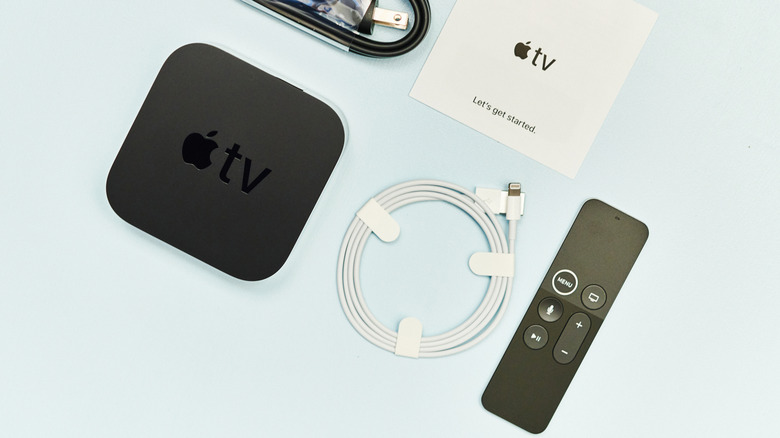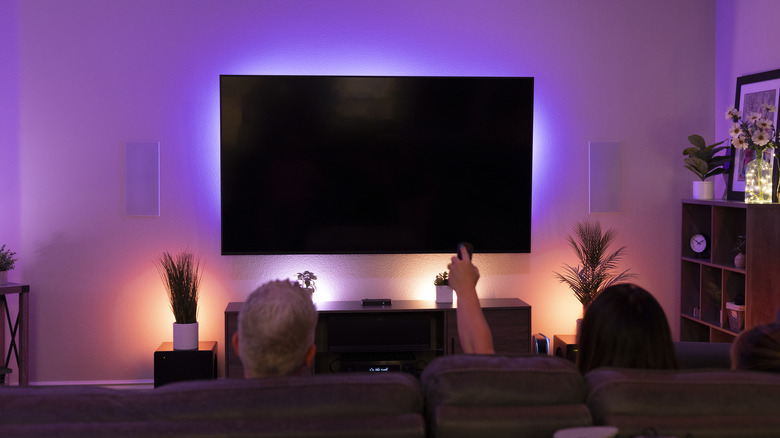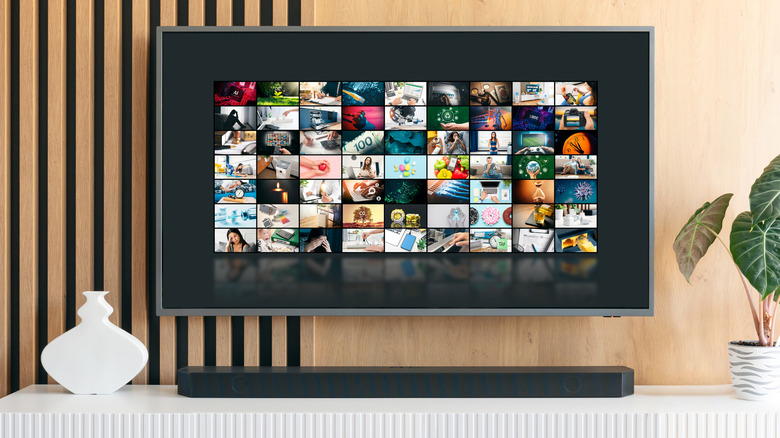5 Essential TV Gadgets You Never Knew You Needed
We may receive a commission on purchases made from links.
The TV is the centerpiece in most living rooms. It's the thing that ties the room together and unites friends and family. The great thing about modern smart TVs is that you don't need much more than they already have. They're mostly all-in-one machines, complete with every streaming app you can imagine. Some TVs from LG and Samsung are compatible with Nvidia's GeForce NOW app, which means you can play video games via the cloud directly on your TV — no console required. That's not to say modern TVs can't benefit from a few essential gadgets.
From wireless headphones that make private listening possible to HDMI switches that expand the number of HDMI ports on your TV, these devices can transform the way you experience your TV, and most options are affordable. Other options, such as soundbars, are a tad more expensive, but they make a big difference. If you're interested in a full, in-depth list, keep on reading below.
Streaming device
Smart TVs already have everything you need to start streaming your favorite shows on Netflix, Hulu, or Amazon Prime. So, it may seem redundant to spend money on a streaming device. The upside of a separate streaming device, like an Apple TV, is that you don't have to relearn a new operating system every time you get a new TV, which is exhausting. You can seamlessly go from your living room TV to your bedroom TV if you have the same streaming device installed on every television. That also means logging into one account on every device, limiting the amount of login information you have to remember.
The other advantage you get is longer software and app support. While newer Samsung TVs offer 7 years of software support, they are outliers. Most TVs, especially those from budget brands, have five years of software support or less. Streaming devices like the Apple TV, on the other hand, receive software support for longer periods. Apple TV HD, a device that was released 10 years ago in 2015, still works fine due to software updates. If you own an Apple TV, you only have to upgrade every 10 years instead of every five, and it's much cheaper than buying a new TV. It's the same for Roku models. Some of which are a decade old and still working.
Headphones
Listening to the TV at your desired volume may not be something you can do all the time. Whether you have kids, thin walls, or roommates who sleep earlier than you do, sometimes you have to turn down the TV, which ruins the experience. Turning on subtitles helps, but it doesn't fix the underlying issue; it just makes it easier to deal with. Rather than perking up your ears or moving closer to the TV, you can connect a pair of Bluetooth headphones to your TV. You'll be able to listen at any volume you want without a care in the world. Once you start doing this, you'll never go back.
This solution only works on smart TVs with Bluetooth connectivity, but if you don't have one, there is a workaround. You can hook up a streaming device to your TV and connect your headphones to it. The advantage of connecting the headphones to your TV is that any sound that goes through your TV redirects to the headphones, including audio from your video game console or Blu-ray player. Connecting the headphones to the streaming device has advantages, too. For example, if you connect your AirPods to an Apple TV, you get the full functionality of the earbuds. The best part is that you can use any pair of Bluetooth headphones, without having to buy new ones.
Light strip
TVs with built-in ambient lighting were popular once, but you don't see them much anymore. It's a shame because they add a lot to a room in terms of vibes. While those TVs have faded out of fashion, you can achieve a similar look with TV light strips. There are many LED light strips available, but the Philips Hue Play Gradient light strip is a good choice because it's designed for TVs. It can sync with other lights in your home, provided you've invested in the Philips Hue ecosystem. The light strip is available in three sizes: 55, 65, and 75 inches. That said, the strip works with any TVs between these sizes, but the light may hang from behind the TV a few inches.
Although many brands make TV light strips, the Philips Hue Play Gradient has a great trick up its sleeve. When paired with the Sync Box, which is sold separately, the light can sync with your TV, displaying an array of colors that match the image. However, you don't need the Sync Box to use the light. You can program it via the Philips Hue app to display whichever colors and effects you desire. What you will need is a Philips Hue Hub, which you'll likely already have if you have other Philips Hue lights in your home. The Play Gradient lights trip is expensive, though — the 55-inch version costs $139 — so if you don't mind forgoing app functionality, you can achieve a similar effect with budget LED light strips, which cost as little as $15 on Amazon.
Soundbar
When buying a new TV, the last thing most people look for is the sound quality of the TV's speakers. Things like picture quality, color reproduction, glare, and smart features take precedence, and they should because they all play a part in delivering a great TV-watching experience. That doesn't mean you should overlook the importance of sound and the part it plays when watching TV. Whether your TV has great speakers or bad ones, a soundbar makes them obsolete. Soundbars like the Sonos Beam, which retails for $499 and is one of the best soundbars of 2024, deliver clear, booming sound that gets you close to the cinema experience that the wimpy speakers on your TV can't. This particular soundbar is compatible with TVs that have Dolby Atmos, which has a soundstage that surrounds you and provides a more immersive experience. To get the most out of this soundbar, you'll need a TV with an open eARC-capable HDMI port.
The Sonos Beam works just like any other soundbar, but, at the end of the day, it's still a Sonos product. If you've invested in the Sonos ecosystem, you can count on this soundbar syncing with your other speakers. You can also link Spotify or Tidal to your Sonos app to play music from those services directly on the soundbar. While the Sonos Beam is a great high-end soundbar at an entry-level price, almost any soundbar is an improvement over your TV's speakers. If you're looking for other options, you may also check the best-rated soundbar and subwoofer combos on Amazon.
HDMI switch
Modern TVs don't have enough HDMI ports for all your devices. Between video game consoles, Blu-ray players, and eARC-capable soundbars, you'll struggle with reaching behind your TV every time you need to use a device. With an HDMI switch, you don't have to worry about a lack of HDMI ports. For instance, the Anker HDMI Switch is a top choice on Amazon because it gives you four additional HDMI outputs. The HDMI switch has a single button to switch between sources, as well as bright blue LEDs that demonstrate which source is selected. However, you don't have to use the button on the device to switch sources. That's what the controller is for. With just six buttons, this controller keeps things simple, and it has a compact design that won't take up too much space on your coffee table.
Although the controller simplifies choosing different sources, the HDMI switch can also switch to a device as soon as it's powered on. Most HDMI switches can detect your TV, console, and physical media player, so everything should be automatic. The device's button and controller are fallback options. HDMI switches range in price, with 4K switches costing around $40, and newer 8K switches costing $60 or more. While these offer a great value, they don't come with HDMI cables. You'll have to supply your own. Just remember to buy the right ones for your TV's ports — get HDMI 2.1 cables if you want support for 4K and 8K content.





